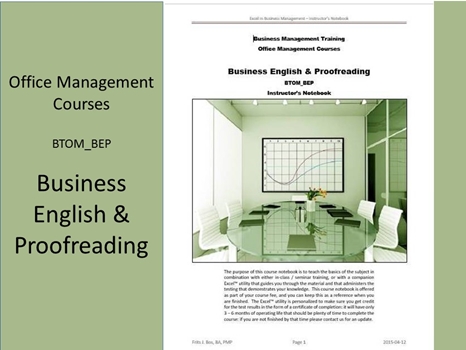
Business English & Proofreading BTOM_BEP
With the current MS-Office technology the issues of proofreading and grammar have been reduced but not eliminated. Furthermore, something can be grammatically correct and fail to meet accepted norms for business English. In Canada specifically, but also in other countries, many professionals have English as a second language: they need help to polish their communications.
The fact that professionals can now type their own documents makes it easier to move thoughts into a format where these thoughts can be shared. The most efficient use of peoples’ skills is to enable them to focus on their strengths: business English usually is not one of those strengths. As an office management professional you can take draft documents of any kind and transform them into communications for publication and distribution. Million dollar projects have been lost as a result of poor grammar and English usage, so the importance of the editing process is well understood in most professional businesses: a good opportunity to find a viable career.
Business English and Proofreading is not an easy subject, because the school system has failed students in mastering these skills earlier in life – this has allowed “bad habits” to become etched in how you approach communications. Many habits will have to be “un-learned” in an effort that takes more time than we have available to complete this course, so we focus on awareness and techniques to hone your language skills and thus to become a more valued communications professional. In this course we focus on how to write formal business correspondence that avoids trite and stiff expressions as well as grammar or spelling mistakes.
Learn how to express facts and recommendations in concise, easy to understand, paragraphs to make your messages more effective in eliciting desired responses and/or actions in a business context. Written communications are especially important to make that all important great first impression.
The ability to communicate effectively can make or break your career. To review these skills we have the following training sessions:
- Introduction:
- - Formal Communications
- - Focused Communications
- - The Art of Composing Communications
- Presentation:
- - Visual & Verbal Communications
- - Routine Communications
- - Reports Communications
- - Internet Communications
- Grammar:
- - Spelling and Grammar in Communications
Formal Communications
- The role of communications in your career development
- How to improve your communications abilities
- The cost/benefits analysis of communications effectiveness
Focused Communications
- Understand your audience and adapt your communications to your audience
- How to design communications to cater to an audience with different characteristics
- How to draw the audience into the communications to make things interactive
- How to avoid bias in your communications
- How to make yourself better understood
The Art of Composing Communications
- Planning and organizing documents
- Researching information that enhances your communications
Visual & Verbal Communications
- The use of PowerPoint and other tools for effective information dissemination
- How to design and structure an effective presentation
- How to deliver an effective presentation using PowerPoint and other tools
- How to handle questions
Routine Communications
- E-mails, Memos, etc., composed for clarity and punch
- How to communicate the “bad news” message effectively
- How to communicate the “selling” message effectively
- How to design sales and marketing collateral
Reports Communications
- Concepts of Technical Writing projects
- Organizing information in reports
Internet Communications
- How to establish a presence on the Internet
- How to create a personal web site and establish a personal URL (web address)
- How to design a powerful web site with effective navigation.
Spelling and Grammar in Communications
- Define and explain the logic of grammar
- Discuss how to identify and correct common punctuation errors
- Explain the uses of punctuation within sentences
- List uses of special punctuation marks
- Distinguish words that are often confused
- Describe the proofreading process.
Learning Formats BTOM_BEP
This course is currently available in a classroom setting (public or company private) with approximately 30 contact hours.
PDF – Certificate Of Completion
This course offers a certificate of completion that identifies the course, the student, and a brief description of the course. To receive a certificate the student must have attended at least 80% of the course sessions. This personalized certificate is forwarded to the student by Email.
PDF – Course Notebook
This course includes a notebook in PDF format that provides the minimum knowledge the student must master in order to obtain the certificate. In the notebook you will find references to other study materials. Students receive the notebook by Email when their registration is confirmed.
PDF – Program Overview
An overview of this study program can be downloaded from the website by right-clicking on the program link on the enquiry page.
PDF – Current Training Schedule
A list of upcoming training sessions can be downloaded from the website by right-clicking on the schedule link on the enquiry page.
Registration – Service Providers
To register for any training course please look on the enquiry link page of your service provider (from where you accessed this website). On the page you will find a registration request form where you can order the course that you are interested in. The availability dates will be provided to you, along with payment instructions if you decide to go ahead.

 |
|